Lab Report: Fire Hazards in Health, Safety & Environment - EGN-3333
VerifiedAdded on 2023/06/11
|10
|1144
|145
Report
AI Summary
This lab report focuses on fire hazards and personal protective equipment (PPE) within a Health, Safety, and Environment course (EGN-3333). It details a chemical laboratory visit, identifying fire classes, fuel sources, and available heat/ignition sources, along with appropriate extinguishing methods...

Faculty of Engineering Technology and Science
Lab Report
Fire Hazards (PPE)
Course Title: Health, Safety and
Environment
Course Code: EGN-3333
Semester: 201730 Academic Year: Spring 2018
Instructor: Dr. Moath J. Date:
Student Name: Student ID:
Student Name: Student ID:
Student Name: Student ID:
Lab Report
Fire Hazards (PPE)
Course Title: Health, Safety and
Environment
Course Code: EGN-3333
Semester: 201730 Academic Year: Spring 2018
Instructor: Dr. Moath J. Date:
Student Name: Student ID:
Student Name: Student ID:
Student Name: Student ID:
Paraphrase This Document
Need a fresh take? Get an instant paraphrase of this document with our AI Paraphraser
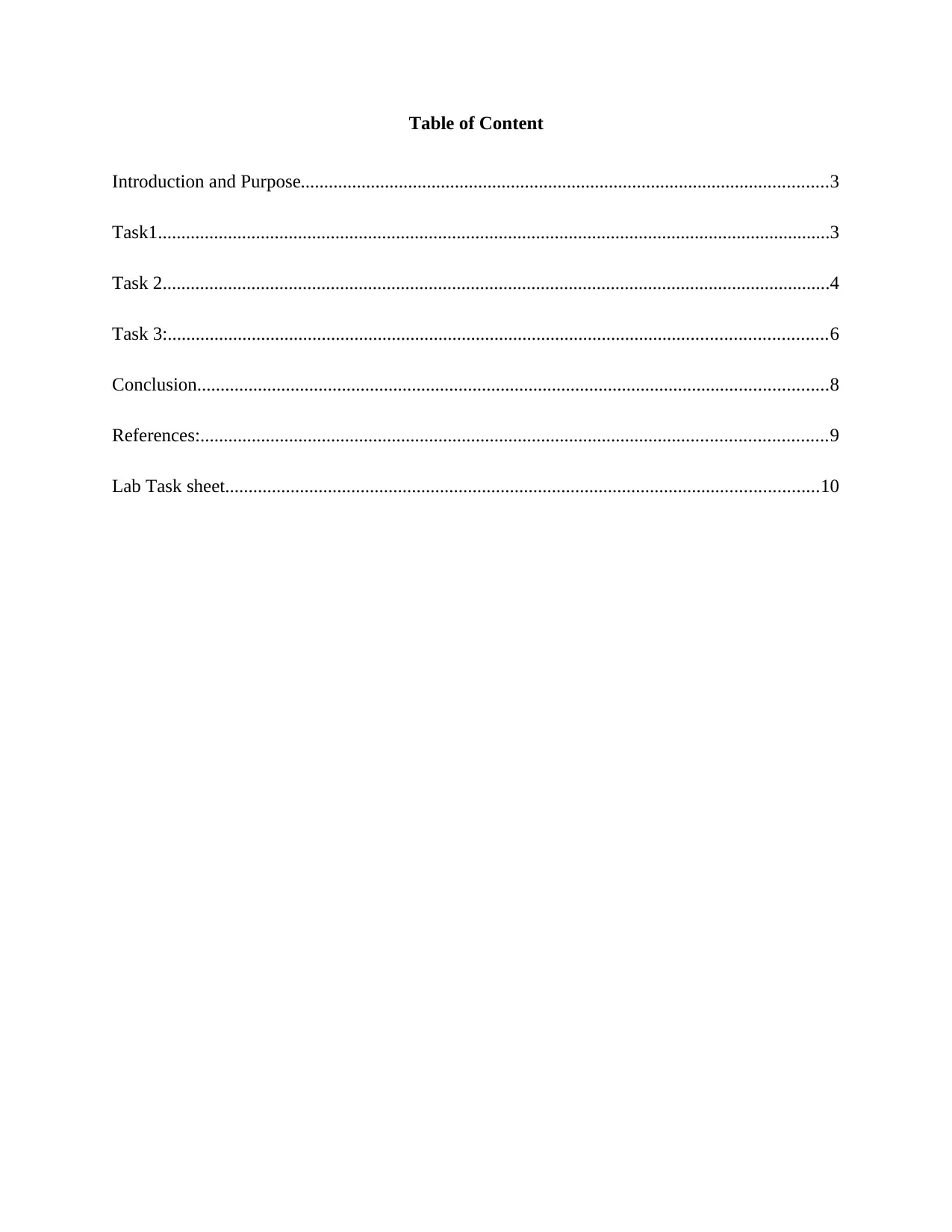
Table of Content
Introduction and Purpose.................................................................................................................3
Task1................................................................................................................................................3
Task 2...............................................................................................................................................4
Task 3:.............................................................................................................................................6
Conclusion.......................................................................................................................................8
References:......................................................................................................................................9
Lab Task sheet...............................................................................................................................10
Introduction and Purpose.................................................................................................................3
Task1................................................................................................................................................3
Task 2...............................................................................................................................................4
Task 3:.............................................................................................................................................6
Conclusion.......................................................................................................................................8
References:......................................................................................................................................9
Lab Task sheet...............................................................................................................................10
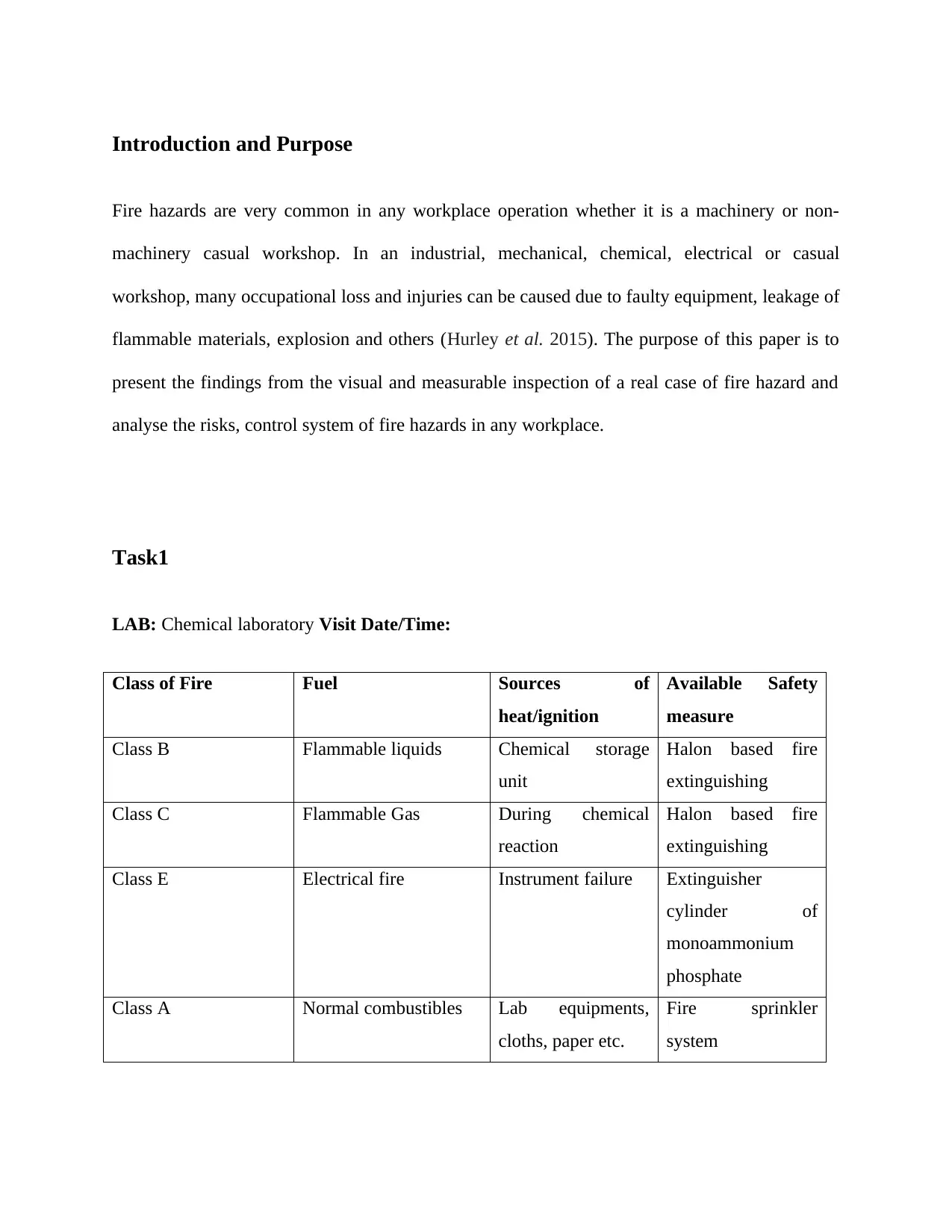
Introduction and Purpose
Fire hazards are very common in any workplace operation whether it is a machinery or non-
machinery casual workshop. In an industrial, mechanical, chemical, electrical or casual
workshop, many occupational loss and injuries can be caused due to faulty equipment, leakage of
flammable materials, explosion and others (Hurley et al. 2015). The purpose of this paper is to
present the findings from the visual and measurable inspection of a real case of fire hazard and
analyse the risks, control system of fire hazards in any workplace.
Task1
LAB: Chemical laboratory Visit Date/Time:
Class of Fire Fuel Sources of
heat/ignition
Available Safety
measure
Class B Flammable liquids Chemical storage
unit
Halon based fire
extinguishing
Class C Flammable Gas During chemical
reaction
Halon based fire
extinguishing
Class E Electrical fire Instrument failure Extinguisher
cylinder of
monoammonium
phosphate
Class A Normal combustibles Lab equipments,
cloths, paper etc.
Fire sprinkler
system
Fire hazards are very common in any workplace operation whether it is a machinery or non-
machinery casual workshop. In an industrial, mechanical, chemical, electrical or casual
workshop, many occupational loss and injuries can be caused due to faulty equipment, leakage of
flammable materials, explosion and others (Hurley et al. 2015). The purpose of this paper is to
present the findings from the visual and measurable inspection of a real case of fire hazard and
analyse the risks, control system of fire hazards in any workplace.
Task1
LAB: Chemical laboratory Visit Date/Time:
Class of Fire Fuel Sources of
heat/ignition
Available Safety
measure
Class B Flammable liquids Chemical storage
unit
Halon based fire
extinguishing
Class C Flammable Gas During chemical
reaction
Halon based fire
extinguishing
Class E Electrical fire Instrument failure Extinguisher
cylinder of
monoammonium
phosphate
Class A Normal combustibles Lab equipments,
cloths, paper etc.
Fire sprinkler
system
⊘ This is a preview!⊘
Do you want full access?
Subscribe today to unlock all pages.

Trusted by 1+ million students worldwide
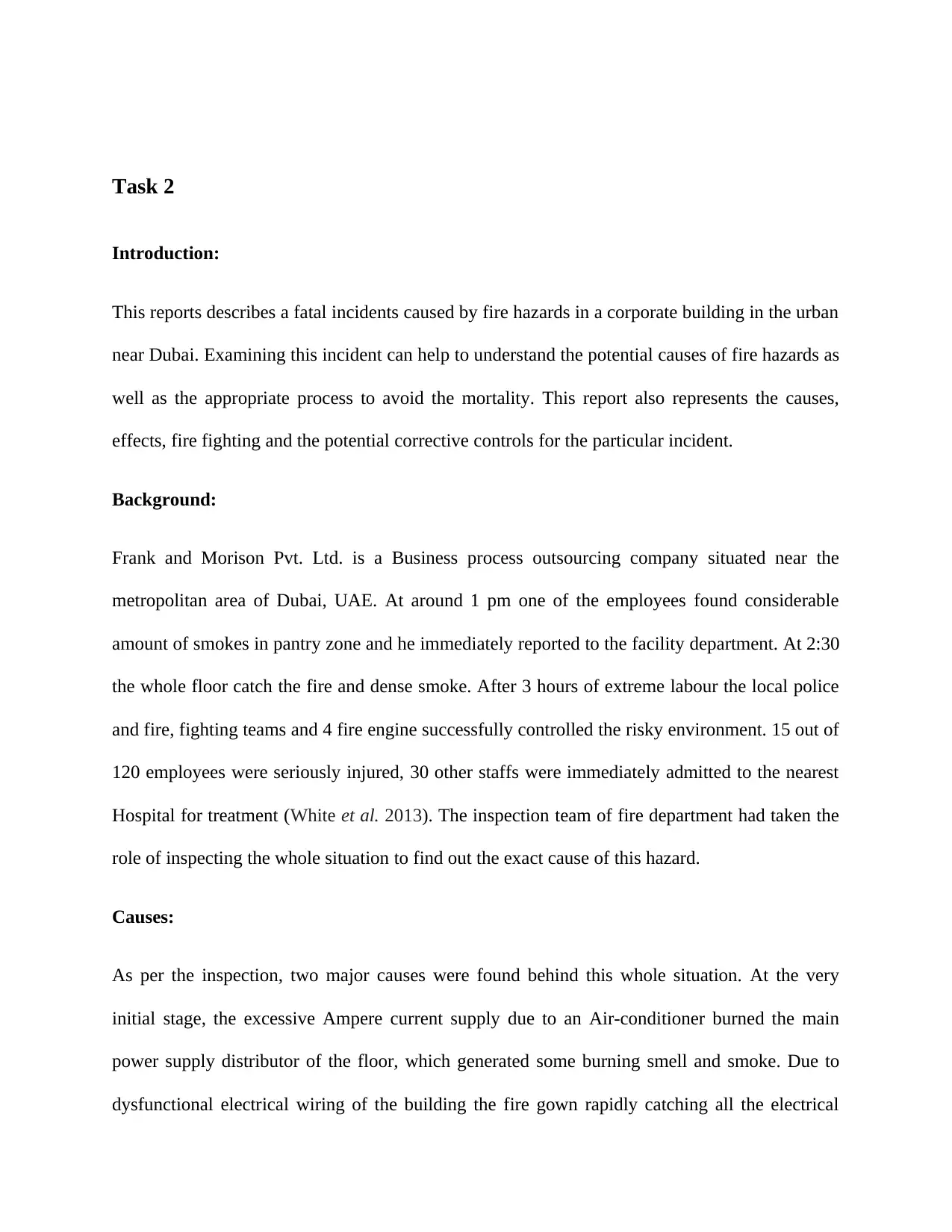
Task 2
Introduction:
This reports describes a fatal incidents caused by fire hazards in a corporate building in the urban
near Dubai. Examining this incident can help to understand the potential causes of fire hazards as
well as the appropriate process to avoid the mortality. This report also represents the causes,
effects, fire fighting and the potential corrective controls for the particular incident.
Background:
Frank and Morison Pvt. Ltd. is a Business process outsourcing company situated near the
metropolitan area of Dubai, UAE. At around 1 pm one of the employees found considerable
amount of smokes in pantry zone and he immediately reported to the facility department. At 2:30
the whole floor catch the fire and dense smoke. After 3 hours of extreme labour the local police
and fire, fighting teams and 4 fire engine successfully controlled the risky environment. 15 out of
120 employees were seriously injured, 30 other staffs were immediately admitted to the nearest
Hospital for treatment (White et al. 2013). The inspection team of fire department had taken the
role of inspecting the whole situation to find out the exact cause of this hazard.
Causes:
As per the inspection, two major causes were found behind this whole situation. At the very
initial stage, the excessive Ampere current supply due to an Air-conditioner burned the main
power supply distributor of the floor, which generated some burning smell and smoke. Due to
dysfunctional electrical wiring of the building the fire gown rapidly catching all the electrical
Introduction:
This reports describes a fatal incidents caused by fire hazards in a corporate building in the urban
near Dubai. Examining this incident can help to understand the potential causes of fire hazards as
well as the appropriate process to avoid the mortality. This report also represents the causes,
effects, fire fighting and the potential corrective controls for the particular incident.
Background:
Frank and Morison Pvt. Ltd. is a Business process outsourcing company situated near the
metropolitan area of Dubai, UAE. At around 1 pm one of the employees found considerable
amount of smokes in pantry zone and he immediately reported to the facility department. At 2:30
the whole floor catch the fire and dense smoke. After 3 hours of extreme labour the local police
and fire, fighting teams and 4 fire engine successfully controlled the risky environment. 15 out of
120 employees were seriously injured, 30 other staffs were immediately admitted to the nearest
Hospital for treatment (White et al. 2013). The inspection team of fire department had taken the
role of inspecting the whole situation to find out the exact cause of this hazard.
Causes:
As per the inspection, two major causes were found behind this whole situation. At the very
initial stage, the excessive Ampere current supply due to an Air-conditioner burned the main
power supply distributor of the floor, which generated some burning smell and smoke. Due to
dysfunctional electrical wiring of the building the fire gown rapidly catching all the electrical
Paraphrase This Document
Need a fresh take? Get an instant paraphrase of this document with our AI Paraphraser
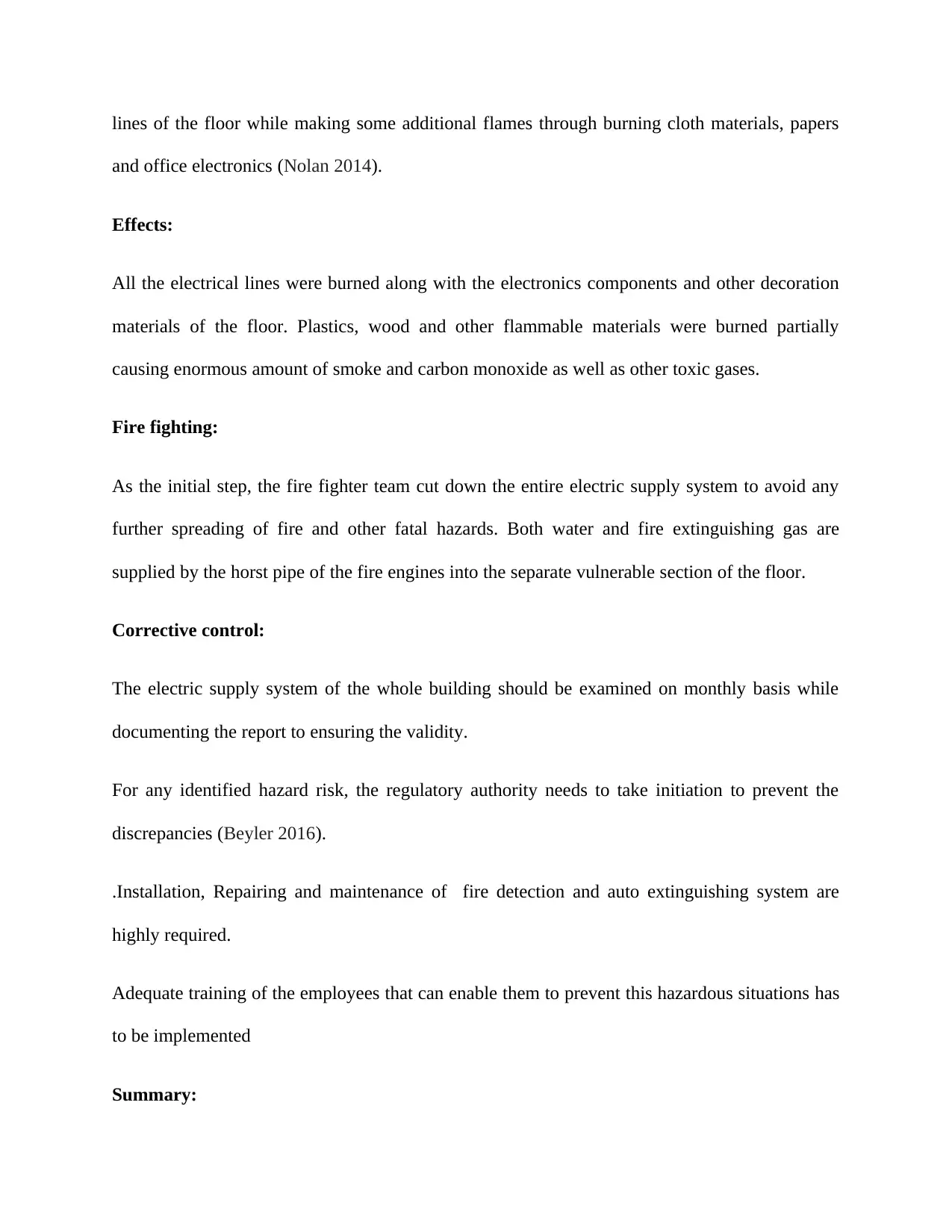
lines of the floor while making some additional flames through burning cloth materials, papers
and office electronics (Nolan 2014).
Effects:
All the electrical lines were burned along with the electronics components and other decoration
materials of the floor. Plastics, wood and other flammable materials were burned partially
causing enormous amount of smoke and carbon monoxide as well as other toxic gases.
Fire fighting:
As the initial step, the fire fighter team cut down the entire electric supply system to avoid any
further spreading of fire and other fatal hazards. Both water and fire extinguishing gas are
supplied by the horst pipe of the fire engines into the separate vulnerable section of the floor.
Corrective control:
The electric supply system of the whole building should be examined on monthly basis while
documenting the report to ensuring the validity.
For any identified hazard risk, the regulatory authority needs to take initiation to prevent the
discrepancies (Beyler 2016).
.Installation, Repairing and maintenance of fire detection and auto extinguishing system are
highly required.
Adequate training of the employees that can enable them to prevent this hazardous situations has
to be implemented
Summary:
and office electronics (Nolan 2014).
Effects:
All the electrical lines were burned along with the electronics components and other decoration
materials of the floor. Plastics, wood and other flammable materials were burned partially
causing enormous amount of smoke and carbon monoxide as well as other toxic gases.
Fire fighting:
As the initial step, the fire fighter team cut down the entire electric supply system to avoid any
further spreading of fire and other fatal hazards. Both water and fire extinguishing gas are
supplied by the horst pipe of the fire engines into the separate vulnerable section of the floor.
Corrective control:
The electric supply system of the whole building should be examined on monthly basis while
documenting the report to ensuring the validity.
For any identified hazard risk, the regulatory authority needs to take initiation to prevent the
discrepancies (Beyler 2016).
.Installation, Repairing and maintenance of fire detection and auto extinguishing system are
highly required.
Adequate training of the employees that can enable them to prevent this hazardous situations has
to be implemented
Summary:
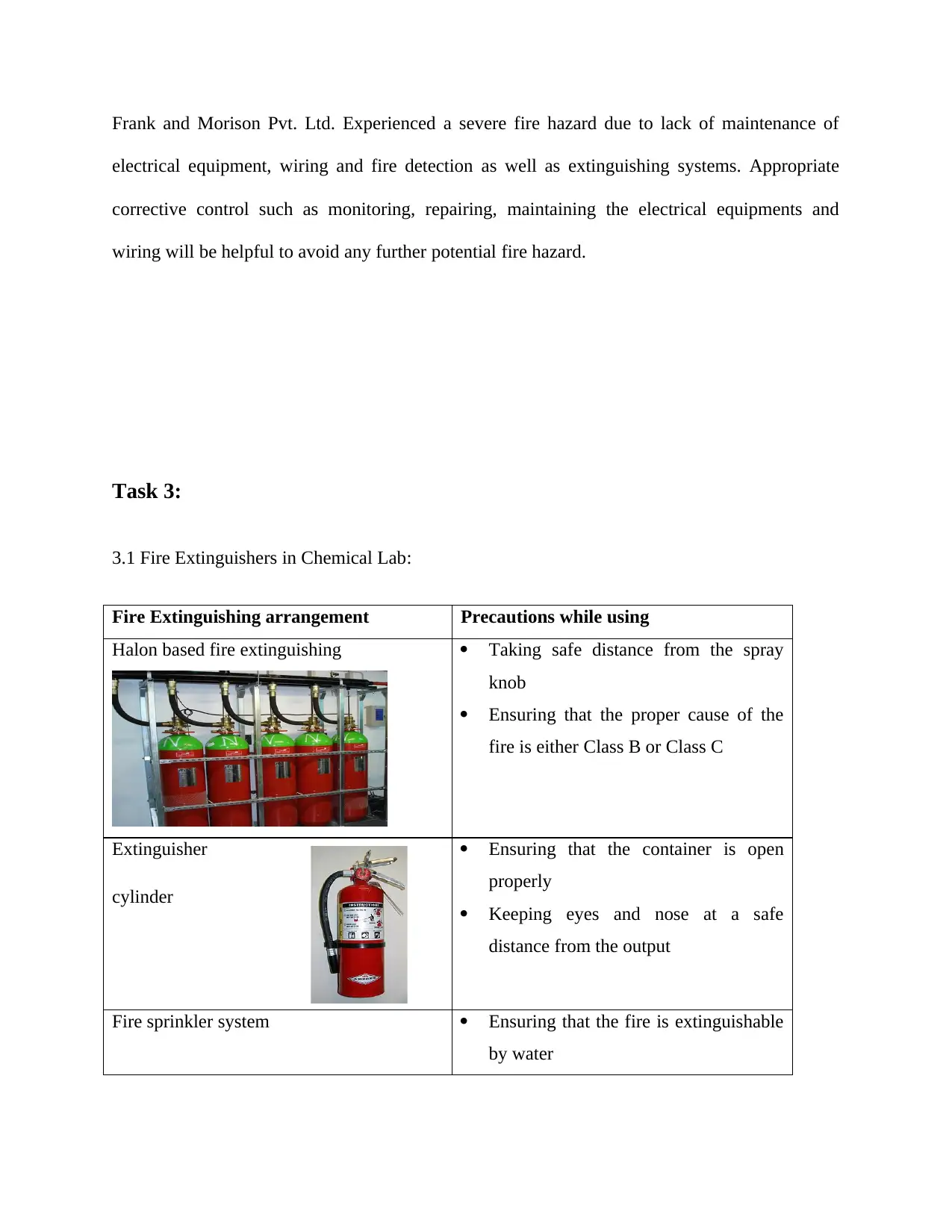
Frank and Morison Pvt. Ltd. Experienced a severe fire hazard due to lack of maintenance of
electrical equipment, wiring and fire detection as well as extinguishing systems. Appropriate
corrective control such as monitoring, repairing, maintaining the electrical equipments and
wiring will be helpful to avoid any further potential fire hazard.
Task 3:
3.1 Fire Extinguishers in Chemical Lab:
Fire Extinguishing arrangement Precautions while using
Halon based fire extinguishing Taking safe distance from the spray
knob
Ensuring that the proper cause of the
fire is either Class B or Class C
Extinguisher
cylinder
Ensuring that the container is open
properly
Keeping eyes and nose at a safe
distance from the output
Fire sprinkler system Ensuring that the fire is extinguishable
by water
electrical equipment, wiring and fire detection as well as extinguishing systems. Appropriate
corrective control such as monitoring, repairing, maintaining the electrical equipments and
wiring will be helpful to avoid any further potential fire hazard.
Task 3:
3.1 Fire Extinguishers in Chemical Lab:
Fire Extinguishing arrangement Precautions while using
Halon based fire extinguishing Taking safe distance from the spray
knob
Ensuring that the proper cause of the
fire is either Class B or Class C
Extinguisher
cylinder
Ensuring that the container is open
properly
Keeping eyes and nose at a safe
distance from the output
Fire sprinkler system Ensuring that the fire is extinguishable
by water
⊘ This is a preview!⊘
Do you want full access?
Subscribe today to unlock all pages.

Trusted by 1+ million students worldwide
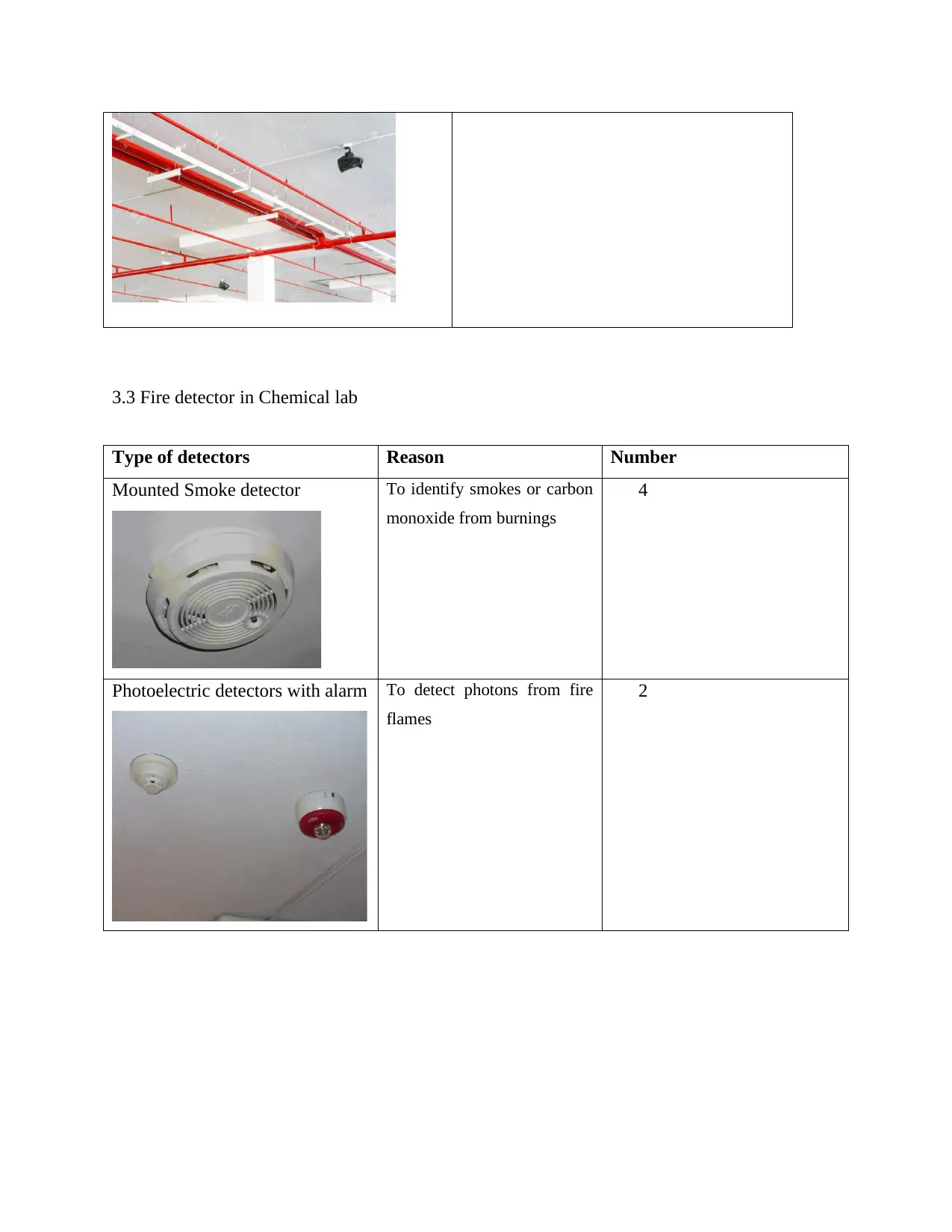
3.3 Fire detector in Chemical lab
Type of detectors Reason Number
Mounted Smoke detector To identify smokes or carbon
monoxide from burnings
4
Photoelectric detectors with alarm To detect photons from fire
flames
2
Type of detectors Reason Number
Mounted Smoke detector To identify smokes or carbon
monoxide from burnings
4
Photoelectric detectors with alarm To detect photons from fire
flames
2
Paraphrase This Document
Need a fresh take? Get an instant paraphrase of this document with our AI Paraphraser
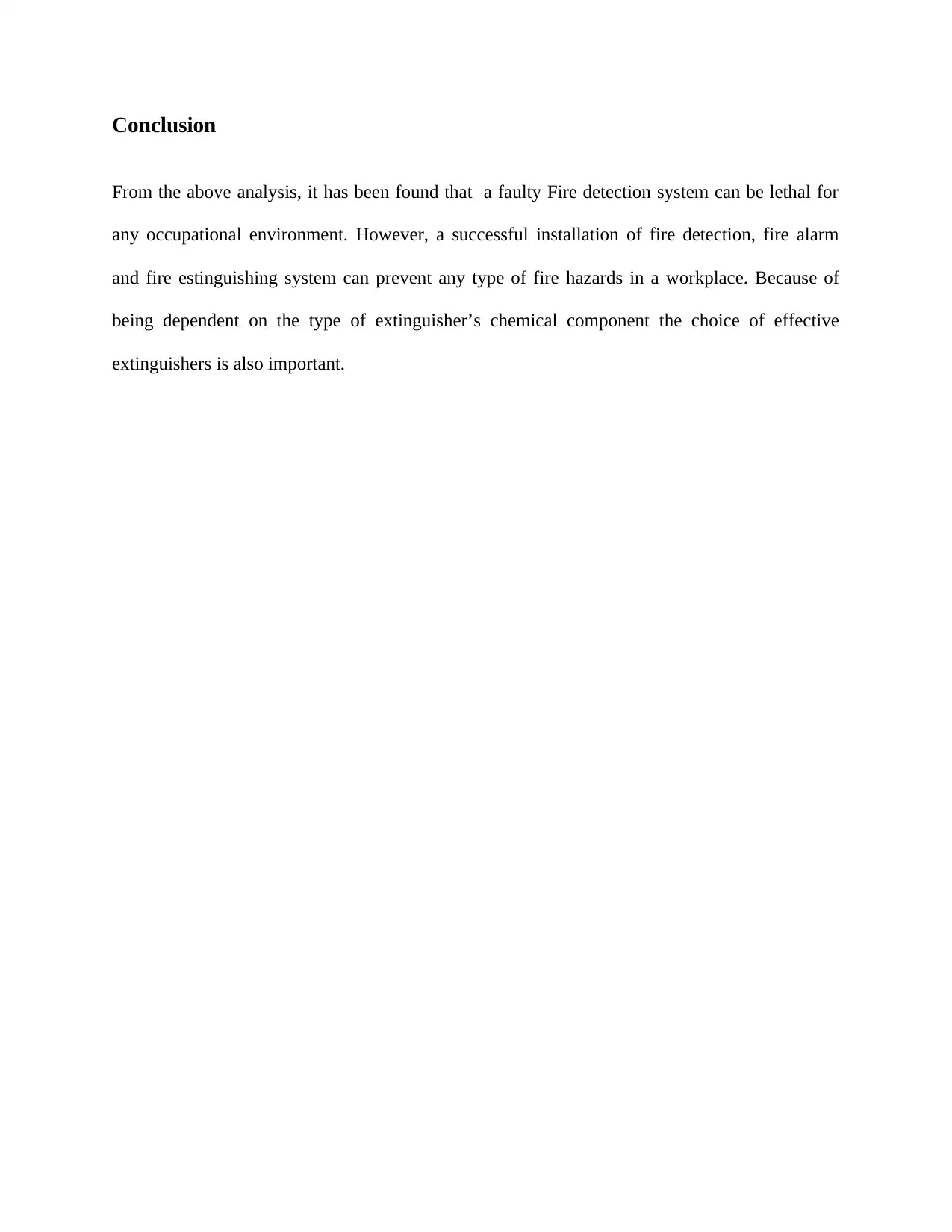
Conclusion
From the above analysis, it has been found that a faulty Fire detection system can be lethal for
any occupational environment. However, a successful installation of fire detection, fire alarm
and fire estinguishing system can prevent any type of fire hazards in a workplace. Because of
being dependent on the type of extinguisher’s chemical component the choice of effective
extinguishers is also important.
From the above analysis, it has been found that a faulty Fire detection system can be lethal for
any occupational environment. However, a successful installation of fire detection, fire alarm
and fire estinguishing system can prevent any type of fire hazards in a workplace. Because of
being dependent on the type of extinguisher’s chemical component the choice of effective
extinguishers is also important.

References:
Beyler, C.L., 2016. Fire hazard calculations for large, open hydrocarbon fires. In SFPE
handbook of fire protection engineering (pp. 2591-2663). Springer, New York, NY.
Hurley, M.J., Gottuk, D.T., Hall Jr, J.R., Harada, K., Kuligowski, E.D., Puchovsky, M., Watts Jr,
J.M. and WIECZOREK, C.J. eds., 2015. SFPE handbook of fire protection engineering.
Springer.
Nolan, D.P., 2014. Handbook of fire and explosion protection engineering principles: for oil,
gas, chemical and related facilities. William Andrew.
White, N., Delichatsios, M., Ahrens, M. and Kimball, A., 2013. Fire hazards of exterior wall
assemblies containing combustible components. In MATEC Web of Conferences (Vol. 9, p.
02005). EDP Sciences.
Beyler, C.L., 2016. Fire hazard calculations for large, open hydrocarbon fires. In SFPE
handbook of fire protection engineering (pp. 2591-2663). Springer, New York, NY.
Hurley, M.J., Gottuk, D.T., Hall Jr, J.R., Harada, K., Kuligowski, E.D., Puchovsky, M., Watts Jr,
J.M. and WIECZOREK, C.J. eds., 2015. SFPE handbook of fire protection engineering.
Springer.
Nolan, D.P., 2014. Handbook of fire and explosion protection engineering principles: for oil,
gas, chemical and related facilities. William Andrew.
White, N., Delichatsios, M., Ahrens, M. and Kimball, A., 2013. Fire hazards of exterior wall
assemblies containing combustible components. In MATEC Web of Conferences (Vol. 9, p.
02005). EDP Sciences.
⊘ This is a preview!⊘
Do you want full access?
Subscribe today to unlock all pages.

Trusted by 1+ million students worldwide

Lab Task sheet
1 out of 10
Your All-in-One AI-Powered Toolkit for Academic Success.
+13062052269
info@desklib.com
Available 24*7 on WhatsApp / Email
![[object Object]](/_next/static/media/star-bottom.7253800d.svg)
Unlock your academic potential
© 2024 | Zucol Services PVT LTD | All rights reserved.